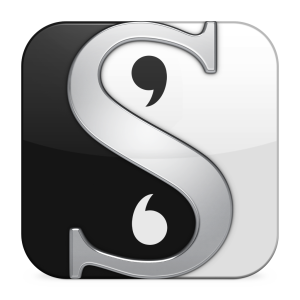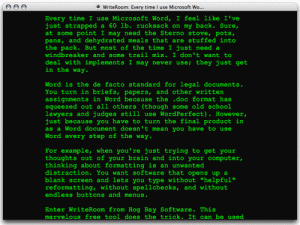All writing tools are not created equal.
Nor should they be.
But the writing tool must certainly meet the writing goal. One of the more flexible and productive, albeit complex tools, is a program called Scrivener. I can’t say enough about this tool, but what I can say is that it is certainly worth the price I paid for it. I do not guarantee it’s right for you, and if you’re looking for a simple, straight-forward text editor, this is certainly not for you. But if you plan to move into self-publishing or maybe you’re already there and are wondering as you make your way through your manuscript what you’ll do with all those words one you finish the last chapter, then it’s certainly worth considering. Multi-featured. Smart. Plenty of documentation. I took an online class to help me understand its ins and outs and highly recommend doing so to avoid time-consuming workarounds and frustration.
The height of cultivation always runs to simplicity.
–Bruce Lee
Even if it’s a funny name, and I have no idea if Hog Bay is near the Bay of Pigs, it has a certain Claustrom ring to it. In the early days of computing, those who remember or care to consult their archives will recall the Wang platform, which set the standard for business, typesetting and word processors. Its black background and green typeface put me into a world without formatting, ads, status updates, all of which interrupt the focus of writing fundamentals, word use and sentence construction.
Yes, it’s a retro feel, and it’s not for everyone, but it’s a bit easier on my eyes than the bright whites of today’s WYSIWYG displays, and its basic text limitations come in handy when cutting and pasting.
Stephen King likes to relate the story of his earlier days of writing which he would spend hours upstairs in his house on his very own Wang computer. He jokes that when his wife would answer the door during his writing sessions, she’d tell the guests that Stephen was “upstairs pounding on his Wang.”
Literally.
I’m not alone. Many similiar programs are now available both as stand-alone programs like Darkroom for PCs and as web-based software like “Writer,” where you register for free access to the program. Even those addicted to MSWord have the option of formatting documents with this theme. I like to do this at work, both for composing and for the priceless look on co-workers faces.
“What HAPPENED to your computer????”
Tee Hee.
And that’s it.
In truth, you don’t need either of these to be a writer. You need discipline, focus and a vision. If you have a computer, you have software that is capable of capturing, saving and outputting words. If you have a notebook and a pencil, or a finger and some sand, or a voice and a tape recorder–or tapeless recorder–you have the capability.
This is just what I use–what I’ve found that works for me. Brother Rob uses a number of different platforms, including the well-featured (and free) collaboration software, Google Docs.
In the end, the writing solutions are not in the software, but as the school nurse likes to say, “all in your head.”

